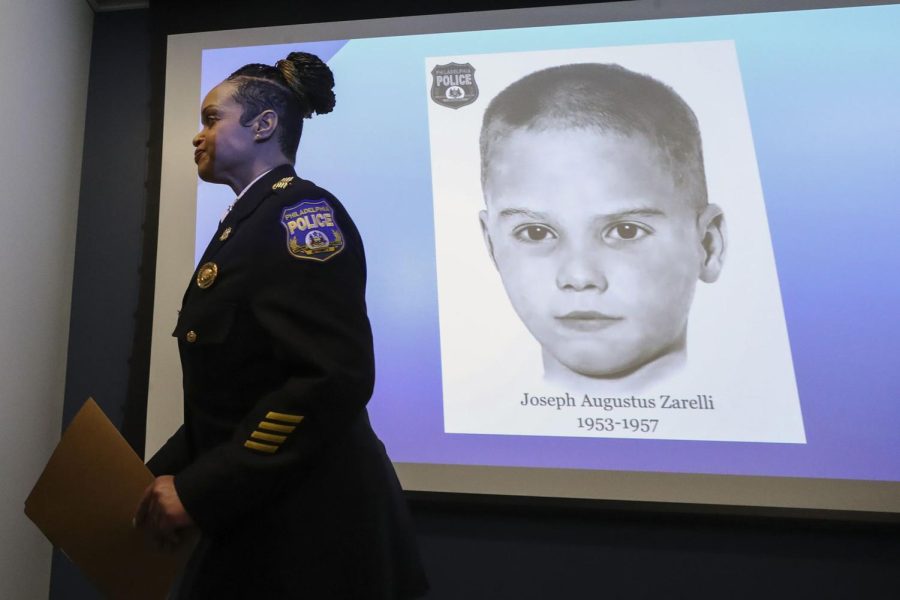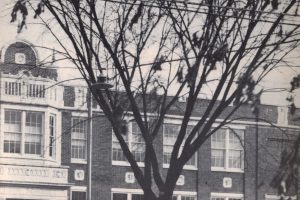Who was the boy in the box?
65 years after a child’s body was found in Philadelphia, police officials announce they have solved the tragic mystery
Heather Khalifa / The Philadelphia Inquirer / TNS
Philadelphia Police Commissioner Danielle Outlaw exits a news conference Thursday, Dec. 8, 2022, after identifying the 4-year-old child referred to as the “Boy in the Box” as Joseph Augustus Zarelli.
February 14, 2023
On Feb. 25, 1957, the body of a boy was found in a box at an illegal dumping ground near Susquehanna Road in Philadelphia, Pennsylvania.
The boy was estimated around 4-7 years old, 30 pounds (malnourished) and stood at about 3’3”. The boy was found wrapped in a blanket, his hair recently cut, and the body was recently washed. The body of the boy was discovered with multiple bruises and multiple scars that implied a medical procedure was undergone prior to his death (most notably on his left ankle, groin, and chin). Head injuries were determined to be the cause of death and there were no witnesses to the boy’s death. Who was this boy found in the box? The identity of the young boy was not found for years, and the boy was deemed “America’s Unknown Child”.
Strangely, it is suspected the young man who discovered the boy’s body waited a full day before notifying the police. With the cold weather at that point in the year, and the delayed phone call by the man who discovered the boy’s body, the estimated time of death was extremely hard to accurately pin-point.
In hopes of identifying the boy, the police kept the body at the morgue while investigators from 10 states tried to ID the body. No available evidence was found. Police also took fingerprints of the boy yet no one ever came forward with useful information.
The Philadelphia Inquirer sent over four thousand flyers of images of the boy at courthouses, police stations, and post offices all over the country. The American Medical Association sent out a description of the boy, but to no avail.
The box of which the boy was found contained a serial number, which pointed to the shipment of a bassinet which was traced back to a JCPenney store 15 miles away. Eerily, before the “Boy in the Box”, the store had shipped twelve of these boxes of bassinets, however all of the purchasers paid in cash, leaving no record. Eight of the purchasers came forward to police saying they still had the box or had put the box out for trash collection. Police were able to determine that the box was shipped to Upper Darby, Pennsylvania.
The blanket that the boy was found in was examined by the Philadelphia Textile Institute which predicted that the blanket was made either in Granby, Quebec, or Swannanoa, North Carolina. Though, it was hard to tell where this blanket was purchased since thousands of these blankets were made and sold. The investigation of the blanket led to a dead-end (Philly Voice).
The scene of the boy’s discovery was combed over and over again by 270 police academy recruits who discovered a child’s scarf, a man’s white handkerchief, and a men’s blue corduroy hat. The Ivy League cap was size 7 and ⅛ and it was labeled Eagle Hat and Company. The hat was made by the small company’s owner, Hannah Robbins, in South Philadelphia. She remembered the man who purchased the hat because she had customized it specifically for him. The man was described as blond, between ages 26 and 30, and requested for a leather strap and buckle be added to the hat. He paid in cash and Mrs. Robbins never saw him again. Detectives visited over one hundred stores within the area but nobody recognized the hat’s owner nor the boy. Another dead-end.
Many theories have been made about the mysterious death of “The Boy in the Box” about what could have possibly happened or who this boy could possibly be. Though most have been dismissed, two theories gained some traction in police and media which were extensively investigated.
The first theory was that the boy was from a foster home that was located approximately 1.5 miles from where the body was found. In 1960, Remington Bristow, an employee of the medical examiner’s office, contacted a New Jersey psychic who led him straight to the foster home. Bristow attended an estate sale at the foster home and noticed that the bassinet was similar to one sold from the JCPenny, and the blankets hanging on the clothesline were similar to the one in which the boy’s body was wrapped in when he was discovered, according to the Philly Voice.
Bristow theorized that the boy had been the child of the owner’s stepdaughter, an unwed mother. Police had established that all the foster children were accounted for and a reexamination by police investigators confirmed that the family was unlikely involved. Police also interviewed the foster father and the stepdaughter. The foster home theory was eventually believed to be a dead end.
The second theory: In 2002, a woman identified as “M” or “Martha” told investigators that the boy, said to be named Johnathan, had been purchased by her abusive mother from another family in 1954. Police considered her story but were hesitant by her testimony as she had a history of mental illness.
It was said that the boy had been physically and sexually abused by her mother for two and half years. The boy was supposed to have thrown up his dinner and the mother had beaten him to death in a fit of rage (his head was said to have been slammed against the floor until he was semi-unconscious). The boy was given a bath, during which he died.
Newsweek reported that the story “M” told seems to be credible, as the remains of the boy’s dinner were found in the boy’s stomach post mortem and the boy’s fingers were found water-wrinkled or pruney. Martha’s mother apparently forced Martha to assist her in dumping the boy’s body in the Fox Chase area. Though Martha’s confession was plausible, police were unable to verify her story. Even neighbor’s of Martha denied that there had been a young boy living there and stated that Martha’s claims were “ridiculous”. Police therefore were unable to justify her claim.
Writing about the case, I decided to indulge in a conversation with my older brother who is another consumer of true crime. He stated, “I know that the stories of how he [the boy] died is unconfirmed but if that story about the mom is true, that is awful. I swear that crimes against kids are always so much more brutal for no reason. I mean you have gotta be a sick person to hurt a kid so the sicker the person the worse they are going to do, but my gosh that is awful.”
“America’s Unknown Child” was an unidentified murder victim for decades but a break in the case was made very recently. On Nov. 30 of last year, the Philadelphia Police Department announced that they have identified the boy through the use of genetic testing and investigative genetic genealogy. Sources provided by these tests proved that the boy was the child of a prominent family in Delaware County, Pennsylvania. On Dec. 8, almost 65 years after his body was found, the boy was publicly identified as Joseph Augustus Zarelli during a press conference held by the Philadelphia Police Department.
People to this day are still mystified as to why nobody had come to claim the boy or entail anything until just recently. Either way, it is good that the mystery behind “The Boy in the Box” no longer remains unsolved. Joseph Augustus Zarelli may now lay his grave marked with “America’s Unknown Child” at the Ivy Hill Cemetery in Philadelphia and finally identified in peace.












Janet • May 1, 2024 at 7:26 pm
I have been reading this case for years. My heart goes out to Joseph Augustus Zarrelli (though identified only later), so young, so innocent yet his death was a violent one. My only consolation is that he is with God now and finds solace in His bosom. Many loves him despite the long period of time he had departed. My sincere respect and commendation to the men and women who helped solved the case, also to the people of the US aw enforcement agencies who did not leave any stone unturned just to find justice for Joseph. God always blesses you all with his graces and keep up the good work. It is worth emulating. My prayers for Joseph.